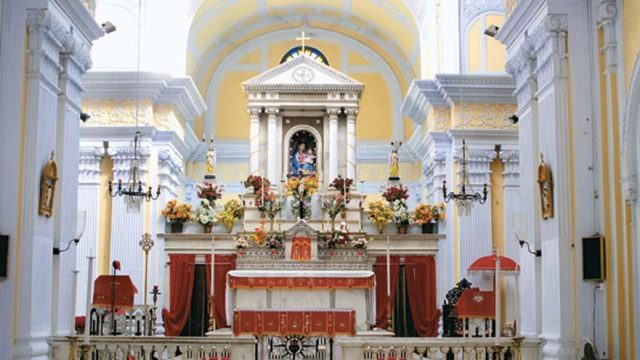A couple of hours from Delhi, in the city of Sardhana, is a sweet little church created, strangely enough, by one of the most powerful women rulers of the 18th and 19th centuries. I say sweet because it is nothing like what you expect; I say strangely because this woman, Begum Samru, the only Catholic ruler in India, converted at the peak of her power and had the humblest of beginnings, starting her life amongst powerful men as a nautch girl. A story well worth an afternoon’s pursuit.
A somewhat lapsed Catholic, I ventured to the ASI-protected Sardhana Church on a Saturday, and made a pleasant day of it. I’d heard potentially apocryphal tales of a church bell that rang on its own, once a year, miracles that took place here, prayers that were answered and requests that were granted. In search of all this and more, I encountered Christians who came from Delhi on an annual pilgrimage, Bengali history students and locals of all faiths; today, families frequently visit the church and its green, mango tree-shaded grounds, and the Begum’s residence nearby, now a boy’s school.
Dedicated to the Virgin Mary and designed by an Italian architect in 1822, the church became a cathedral for a short time; and in December 1961, Pope John XXIII conferred the title of a Minor Basilica to the church, an honour reserved for the most beautiful and historically prominent churches. Yet when you approach the Begum’s Church, as it is called, it is not quite the grand, stately spectacle evoked by that lovely word, basilica.
Painted white and yellow (restoration is in progress), bordered by Doric pillars, and surrounded on either flank by a procession of newly built Biblical statues — mysteries of the holy rosary — the Sardhana Church is a bit of a conundrum. But a pleasing, charming one at that. Even the altar, a previous Sardhana visitor and blogger had noted, is unusual, almost Kashmiri, with its colourful Mary and Jesus, bright red-blue-purple-yellow — a far cry from the understated Syrian Catholic churches from my childhood visits to Kerala. The huge tableau inside is particularly compelling; the Begum herself atop its pyramid-like structure, something intriguing yet delicate about her face, despite its marble blandness
In the 19th century, Sardhana had been Begum Samru’s capital; she was the head of a professionally trained mercenary army she inherited from her French husband, Walter Reinhardt. Begum Samru, also known as Zebunissa, Farzana and Joanna after baptism, was the daughter of Latif Ali Khan, a nobleman of Arabian origin. Born in the 1750s, near Meerut, she had fallen on hard times when her father died and moved with her mother to Delhi, impoverished. Says a Father Keegan who once lived in Sardhana, “She had a graceful way; and she must have been uncommonly beautiful at the age of 15, to have caught the eye of Walter Reinhardt.” The Begum was unusually intelligent as well, and spoke and read Hindustani and Persian fluently. And thus this Cinderella story came about: a dancing girl caught the attention of dashing commander Reinhardt, popularly known as Samru (a native corruption of ‘Le Sombre’ which was what his European friends called him, because of his swarthy complexion and sombre expression).
Not just a Cinderella story but an epic one too, I was to discover, as I sat down with a little history of Sardhana and its begum. For, countless tales emerged: Begum Samru took on a man’s position and became a warrior queen when her husband died. Samru’s officers and troops, the story goes, petitioned Emperor Shah Alam II to install the Begum as her husband’s successor. Fascinatingly, stories of the Begum’s prowess as a military leader spread widely and with such fervour that it was rumoured she was a witch and had only to spread out her chaddar to destroy her enemies!
Then there was the old tale of family feuds — the Begum’s stepson Zafar Khan became a powerful foe when he, along with her principal lieutenant, and a spurned lover, began to conspire with her battalions. Married again to another charming Frenchman, the Begum considered surrender to the Sindhias on condition that she could keep her private property. But this led to revolt, and the Begum and her husband fled by night, making a Romeo and Juliet-esque suicide pact as they were pursued. Each attempted to kill him/herself when they thought the other was dead. The Begum failed when her dagger glanced off a rib. In the spirit of the times, she was then tied to a gun carriage and exposed to the sun for seven days without food or drink, until the rejected admirer came to her rescue. No wonder then, that the Begum, Elizabeth-like, decided to abstain from lovers and be a ruler first and last, ruling on till, in her eighties, when she died after a brief illness. In Sardhana, by her church, she lies buried.
Stunned by the wildness of these tales in settings that seemed almost commonplace, I sat by the Begum’s tomb after mass — the priest had, unsure if I was a Catholic, dubiously given me communion — listening to the pilgrims. “This place looks like a temple, church and a mosque all in one!” someone exclaimed, perhaps exaggeratedly. But the hyperbole served only to remind me that it is in the most prosaic of settings, even in these times of communal violence, that history and stories thrive and prevail.
Sardhana is approx. 80km from Delhi and 18km from Meerut.




